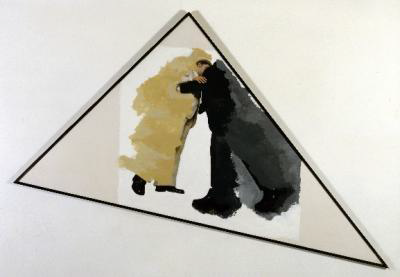Science4Arts
News — Feb 20, 2012
As part of its Science4Arts program, the Netherlands Organization for Scientific Research (NWO) has awarded Leiden University and the Stedelijk Museum Amsterdam 600,000 euros for a project dedicated to developing research and conservation strategies for contemporary photographic works. The research focuses on photo-works that combine different materials and techniques. It examines the chemical and physical qualities of a work alongside its meaning, content and context. This is the first time that a team of specially selected conservators, chemists, curators and other art historians will perform research of this scale in this field. Where possible, artists will also be involved in research related to their artworks.
Photographs consist of chemicals on paper or another carrier. While they are never entirely stable, a museum strives to preserve and display them as long as possible. This is more of a challenge for photo-works onto which another medium has been applied, which is frequently the case in contemporary art. One such example is Ger van Elk’s Russian Diplomacy (1974), for which the artist applied acrylic paint onto part of a photo. Paint’s qualities differ from those of photography, and as a result, they may react with each other. Due to aging, Van Elk’s work now looks different than when it was first made; the relationship between the colors has altered. An additional concern involves the hand-applied paint, which makes the piece a unique work of art.
How can we conserve photos and photo-based artworks in which different media are incorporated or unusual techniques are employed? Can discoloration be prevented? A great deal is known about the degradation as well as the conservation and preservation of photos, but which methods should be used when dealing with the complex photographic art of recent decades? With this research project, the team of conservators, chemists and art historians hope to find ways of stabilizing such artworks before it is too late. Research topics include identifying the undesirable interactions of different materials and targeting optimal conditions for storing and preserving these works.
The research consists of three inter-related sub-projects — two of which relate to PhD research, one at Leiden University (Prof. Dr. Kitty Zijlmans) and one at Utrecht University Utrecht (Debye Institute, Prof. Dr. Leo Jenneskens). The third sub-project will be conducted at the Stedelijk Museum. The artifacts will mainly be post-1960s photographic works to which different materials were applied or that were made using unconventional techniques. Included are significant works by artists such as Joseph Beuys, Ger van Elk, Gilbert & George, Richard Hamilton, Anselm Kiefer and Aernout Mik from the collections of the Stedelijk Museum, Van Abbemuseum and Kröller-Müller Museum, among others. Foreign museums of contemporary art and universities are making their expertise in the field available, thereby also contributing to the research.
The project will run for four years and conclude with an international symposium in which results will be presented and discussed. Research will be led by Prof. Dr. Kitty Zijlmans of Leiden University, which is known for its expertise relating to the discipline of photography, and by Drs. Sandra Weerdenburg, Head of Conservation, Stedelijk Museum Amsterdam. Paper conservator Monica Marchesi of the Stedelijk Museum will be responsible for the day-to-day coordination of the project and the third sub-project. Hripsimé Visser, Photography Curator at the Stedelijk Museum, will be closely involved .
In addition to support from the NWO, the project will receive structural contributions from:
The Cultural Heritage Agency of the Netherlands (RCE), the Kröller-Müller Museum in Otterlo, the Van Abbemuseum in Eindhoven and Stedelijk Museum Amsterdam, all in The Netherlands.
A selection of the parties involved in this project:
Leiden University; Stedelijk Museum Amsterdam; Utrecht University (Debye Institute for Nanomaterials Science); Cultural Heritage Agency of the Netherlands; Kröller-Müller Museum, Otterlo; Van Abbemuseum, Eindhoven; Foto Restauratie Atelier VOF, Amsterdam; the Museum of Modern Art, San Francisco; Stichting Restauratie Atelier Limburg; Eyes on Media, Amsterdam; Lüdwig Museum, Cologne; Getty Museum, Los Angeles; TNO, Delft; Foundation for the Conservation of Contemporary Art; Rijksmuseum, Amsterdam; Louisiana Museum of Modern Art, Humlebæk, Denmark; Tate Gallery, London; University of Amsterdam; Nederlands Fotomuseum, Rotterdam; Eye Film Institute Nederland, Amsterdam; Museum Folkwang, Essen, Germany; Museum Boijmans Van Beuningen, Rotterdam; Rochester Institute of Technology, New York; De Verbeelding, Purmerend.
NWO Science4Arts The NWO (Netherlands Organization for Scientific Research) is helping to fund research projects as part of its Science4Arts program, which supports multi-disciplinary research into the conservation and restoration of art. Artworks are permanently vulnerable to change: their material compositions are affected by chemical and material processes; their physical contexts change and, with each successive generation, the viewer’s experience of works is different. Both the art object and the experience of art are thus determined by a highly complex inter-relationship of material and immaterial conditions. In theory and in practice, this influences our interaction with art objects and subsequently the views and considerations regarding degradation, conservation, restoration, and the presentation and transference of the different values. The Science4Arts research program focuses on changes in art, including the chemical and physical dynamics of the object, its meaning, its content and its context. The main focus of the project is on the collaboration between conservators, art historians and chemists who jointly research an object or related objects within the museum context. The program strives to further develop and reinforce the exchange between the research institutions and the museum sector. Two research areas are pivotal to the program: older art and modern and contemporary art. While the Netherlands plays a leading role in conservation and restoration, this program aims to strengthen and expand this pioneering position through an approach in which the different disciplines―chemistry, art history and restoration―are integrated.
Note for editors:
For more information, please contact the Press Office of the Stedelijk Museum Amsterdam, Marie-José Raven, +31 (0)20 – 573 26 56, m.raven@stedelijk.nl, pressoffice@stedelijk.nl.
